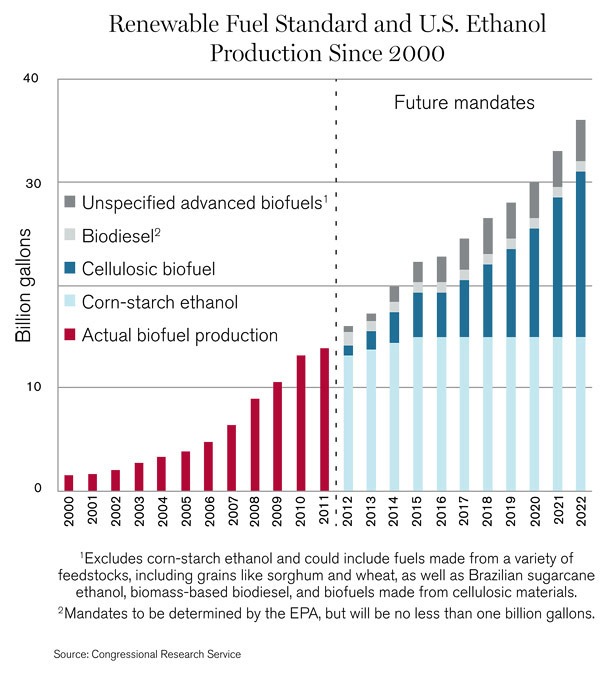U.S. Will Be Hard-Pressed to Meet Its Biofuel Mandates

Under the 2007 Renewable Fuel Standard (RFS), the U.S. Environmental Protection Agency stipulates that gasoline and diesel refiners must blend a certain amount of “renewable fuel” into their products or face penalties.
The vast majority of the biofuel being produced now is corn-derived ethanol, on which the RFS places a cap of 15 billion gallons by 2015. So to satisfy the federal mandate that 36 billion gallons of biofuel be blended into the overall supply by 2022, the U.S. biofuels industry will have to produce a substantial amount of other types of biofuels—especially cellulosic ethanol, which can be made from wood chips and grasses.
But in 2007, Congress vastly overestimated the government’s ability to create a market for cellulosic biofuels, which remain much more expensive to produce than corn ethanol. There was no commercial production of cellulosic fuel in 2010 or 2011—even though the 2007 law originally called for 100 million and 250 million gallons, respectively, for those years (the requirements were subsequently scaled back to around 6.5 million gallons for each year). The chart above shows the actual biofuel production, so far, compared to future mandates.

In 2012, the EPA posits—based on its analysis of the six facilities scheduled to come online this year—that the fledgling industry will have the capacity to produce nearly 10.5 million gallons, compared to the original goal of 500 million. The chart above shows a breakdown, by company and facility, of the EPA’s projections for 2012 cellulosic biofuel production.
Several more facilities should begin commercial production in 2013, but it’s hard to believe that the industry will come even close to producing a billion gallons—the goal for that year, set by Congress in 2007. And the 2022 mandate of 36 billion total gallons of biofuel—16 of that cellulosic—is looking more unrealistic every year.
Keep Reading
Most Popular
Large language models can do jaw-dropping things. But nobody knows exactly why.
And that's a problem. Figuring it out is one of the biggest scientific puzzles of our time and a crucial step towards controlling more powerful future models.
How scientists traced a mysterious covid case back to six toilets
When wastewater surveillance turns into a hunt for a single infected individual, the ethics get tricky.
The problem with plug-in hybrids? Their drivers.
Plug-in hybrids are often sold as a transition to EVs, but new data from Europe shows we’re still underestimating the emissions they produce.
Stay connected
Get the latest updates from
MIT Technology Review
Discover special offers, top stories, upcoming events, and more.